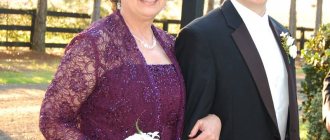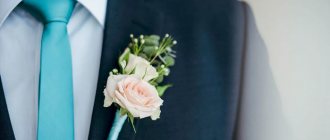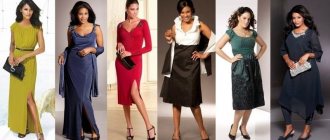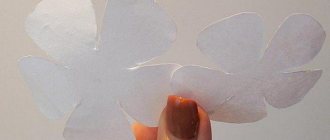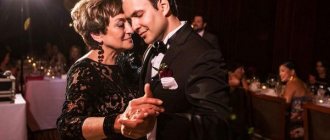The most important accessory in a groom's outfit is undoubtedly a wedding tie. It is he who makes the image complete and stylish. In order for the tie to harmoniously complement the suit and give the hero of the occasion an elegant look, you need to choose it correctly and then tie it.
There are general rules for choosing this important accessory for a man’s wardrobe and rules for creating a wedding outfit. In this publication we will look at how to choose a groom's tie for a wedding, taking into account the listed rules.
How to choose the right tie?
Ties for the groom for the wedding.
You should know the most important criterion for buying a tie. It is matched to the suit, and not vice versa. The color of the accessory should be one tone lighter than the jacket and one tone darker than the shirt. For suits with a print, for example, stripes or checks, a plain model is ideal.
Experts advise when choosing its color to focus on the shade that is less in the print applied to the fabric than the others. This way you highlight it and make the outfit more harmonious.
A plain suit can be refreshed with a printed accessory or a model made of a plain fabric in a contrasting color. One of the fashion trends for creating a modern image of the groom is a black suit, white shirt and black accessory.
Light suits are paired with light accessories of the same color, but in a different tone. Wanting to achieve greater contrast in their attire, men prefer bright items.
Focus on your body type
The groom will be able to choose the perfect tie for the occasion from a wide range of accessories, if he takes into account his physique. If you are tall and have a thin build, you should choose wide models. They can have a large pattern or a pattern on jacquard fabric or horizontal stripes.
https://www.instagram.com/p/Bv1vxqmhFP8/
Tall guys with a large build also need to choose wide accessories, but in completely different colors. The best choice is plain products or a clearly marked geometric print. Young men with average build and tall stature can afford to choose any model they like. Their figure is considered universal and does not need to be corrected with accessories.
This is interesting: How to choose a bow tie or bow tie for the groom?
Groom with a red tie.
Representatives of the male population who are short and thin should wear plain models or with stripes applied along the length of the product. In addition to the listed models, plump men of short stature can choose products with small prints.
Taking into account the bride's outfit
The bride and groom are together almost all the time at a wedding, so their outfits should look harmonious. When choosing a tie, you should take into account the color of the wedding dress and the bride's bouquet.
The bride, who chose the timeless classic – a snow-white outfit, freed the groom’s hands with the selection of accessories. White color goes well with all shades. He only needs to take into account what the bouquet will be. According to the rules, the groom's tie and the bride's bouquet must be in the same color scheme.
When the bride has chosen a dress for her wedding in a fashionable shade of blue or soft ivory, the groom needs to choose a model only from the color range that goes well with these colors. Ivory looks harmonious only with a palette close to it - beige, sand, coffee and brown shades. Shades of blue, gray and pink go well with blue.
We sew a butterfly with our own hands
We suggest you sew not a classic bow tie, which you need to carefully tie every time before going out, but a ready-made accessory with an elastic band. It looks no worse than a self-knitting machine, but is much more convenient to use. In addition, this accessory is distinguished by its regular shape and neat appearance.
Choosing fabric
To sew a butterfly, it is recommended to choose thick fabrics. They will keep their shape well and go well with jackets of different styles. If you prefer a classic style in clothes, opt for plain fabrics. If you want to slightly spice up your look, choose a fabric with an unobtrusive pattern.
Fans of extravagant clothing can choose a plain fabric in a bright color or a fabric with checkered, striped or polka dots in bright shades. But you should not give preference to overly bright shades
It is important to know when to stop so that the color of the accessory does not draw all the attention to itself, making the groom’s image inharmonious.
We suggest taking gabardine suiting fabric. Its advantages are that it practically does not stretch and has optimal thickness. You will need:
- Gabardine – cut 30x15 cm.
- Adhesive interlining – 25-14 cm.
- Elastic band with a width of 12 mm - 50 cm.
- Hook and adjuster for bras with a width of 12-13 mm – 1 pc.
- Threads to match the fabric.
- Ruler, chalk, pins and scissors.
The width of the adjuster and hook must be selected taking into account the width of the elastic band.
Step-by-step algorithm for sewing an accessory
During duplication of the main adhesive fabric, some shrinkage occurs. Therefore, you need to glue it first, and only then cut out the parts. To duplicate gabardine you need to apply adhesive interlining on the wrong side and hold the iron for a few seconds, and then try to tear off the adhesive from the edge. If it comes off, hold it on for a few more seconds. A well-glued interlining does not come off.
Accessory manufacturing algorithm:
- We cut out a piece of 25x14 cm from adhesive non-woven fabric. We glue it onto a piece of gabardine from the edge so that part of the cut remains unglued.
- On the glued part of the cut, draw with chalk the main part 24x13 cm, and on the non-glued part - a lintel part 7x4 cm.
- Carefully cut out both parts.
- Fold the main piece in half widthwise, face inward, and fasten with pins.
- Sew along the long side. All seam allowances are 5 mm wide.
- Turn the piece right side out.
- We iron it so that the seam is in the middle, and the allowances are ironed in different directions.
- We fold the part in half lengthwise, but be sure to have the seam facing outwards and stitch it. It turns out to be a ring made of fabric.
- We turn the part inside out so that the seam is inside and in the middle.
- Iron the seam, ironing the seam allowances. The main part of the butterfly is ready.
- We make a jumper. Fold the small piece in half widthwise and stitch it.
- Turn it right side out, trying to spread out the seam allowances.
- Iron it, leaving a seam in the middle.
- We fold the jumper in half lengthwise, with the seam facing out, and stitch it.
- We turn out the jumper. It turns out to be a ring with a seam inside.
- We form beautiful symmetrical folds in the main part and push it through the jumper. The butterfly is ready.
- We thread an elastic tape through the jumper from the seam side.
- We insert one edge of it into the regulator, then the hole of the hook and again into the regulator from the inside. We secure the end of the tape manually. We insert the other edge into the loop hole, and sew the tip.
You have a beautiful finished bow tie with an adjustable elastic band strap.
Practical advice for the groom
Armed with our tips, you can choose the perfect accessory color to match your suit. But you might be a little puzzled by the fact that it has a length and a width. We will look at how to choose them correctly. Ties are sewn with a length ranging from 125-145 cm. The taller a man is, the longer the accessory he needs.
There is a rule that allows every man to choose the optimal length of the product for himself. If you attach one end to the collar, the other should reach your knee. The groom who wants to tie a complex knot will need a longer product.
The width of the accessory varies from 8 to 14 cm. Sometimes designers develop very wide models of about 16 cm, but they only suit tall men of average build. The most popular width is 8-12 cm. This is what you should focus on. Gentlemen of large build should choose products with a width of 13-14 cm.
This is interesting: What is the best butterfly for the groom for a wedding?
A man looks harmonious when the accessory and the lapel of his jacket are almost the same width. According to the second rule, the longer the shoulder seam of the jacket, the narrower the groom's tie. Shoulder length depends on the size of the person. Wide models look harmonious on slender young men. Overweight men should choose narrower models.
Having selected several models you like, take off your jacket and, hanging it on a mannequin or hanger, bring the items to it one by one and examine, as if from the outside, their combination. Having decided on the product, evaluate the quality of all its seams. Then hang the accessory on your outstretched arm and watch how it hangs. A high-quality product will hang gently on your hand without creating any distortions.
Light blue tie
Light blue tie
A light blue tie is great for summer and warmer seasons. Very popular at weddings because... looks great with a white shirt and a cornflower boutonniere. Looks very fresh and young, especially on such an important day as a wedding.
A light blue tie is suitable for:
- dark blue suit;
- dark gray suit.
Light blue tie suits shirts:
- white;
- light blue color;
- light purple color.
You can buy a blue tie in our online store Bowandtie Shop Gallery.
Other accessories
The groom who wants to create a bright image can choose a butterfly or a neckerchief.
Butterfly
It is customary to choose a black bow tie for a tuxedo, and with a black suit you can combine either a black accessory or other colors, as well as prints. Butterflies in burgundy or red shades look elegant.
The rules for choosing the color of a bow tie for a suit and shirt are the same as for a tie. Young grooms for a casual wedding can choose a bright butterfly with a print for a checkered suit.
Neckerchief
Neck scarves are very comfortable to wear, and tying them is not difficult. There are many videos on the Internet that allow you to master this art. All scarves have a very beautiful combination of colors and fabric texture.
The rules for selecting an accessory for a suit are similar to those described above. A beautifully tied, well-chosen neckerchief allows the groom to create a solemn and stylish look
How to replace a classic tie
People try to dress appropriately for a holiday, especially when it comes to their own wedding. A tie completes the look, but this item of clothing has long become an everyday item; it is worn every working day. To add solemnity to the image, you need to choose something else, for example, a butterfly or a neckerchief. These things will make the groom's image unusually sophisticated and solemn.
Butterfly
Unlike a classic accessory, a butterfly is not an element of a daily business suit; it is worn only on special occasions. With such outfits as a tuxedo and tailcoat, it is customary to wear only a bow tie; wearing a tie at the same time as a tailcoat and tuxedo is bad manners. A white bowtie is worn with a tailcoat, and a black one is worn with a tuxedo or a shirt with a stand-up collar. If the newlyweds are having a themed or democratic wedding, the butterfly may have a different color - turquoise, red, purple, light green.
Neckerchief
If the groom wants to look unique, a neck scarf is what you need, because few grooms use this item to create their wedding look. The scarf will be combined with a classic jacket and tailcoat, as well as with an unusual vest or stylish shirt. Stylists recommend wearing a scarf for men who have a disproportionately long or short neck: the scarf will make this defect less noticeable.
How to tie a tie correctly?
Before tying your tie, fasten all the buttons on your shirt. An unbuttoned top button is allowed only in club style. When the accessory is tied correctly, its wide end half covers the trouser belt buckle, and the narrow end is 2-3 cm shorter.
This is interesting: What is the best butterfly for the groom for a wedding?
A serious mistake is considered to be a tie that does not reach the buckle so much that the bottom button of the shirt is visible. It is also unacceptable when the narrow end of the product peeks out from under the wide one. The knot should not be tightened too tightly. It will look ugly.
Varieties
True fashionistas know that the choice of neck accessories is huge. Shawls, ties and scarves differ in cut, size, and tying features. Original and noble accessories are worn at a wedding.
Less formal events require more modest accessories. Connoisseurs of men's fashion claim that a man, having several different style scarves in his wardrobe, can change his look without changing his suit.
Ascot
The first on the list of fashionable men's neck accessories is the ascot. This is a proven solution for bright events and social events. Often, an ascot refers to a cravat, although a cravat is more of a collective name for neckerchiefs for men.
This accessory has a long history, and traditionally, ascots are still worn at important sporting events - golf, horse racing and evening outings. The ascot is tied so that most of it peeks out from under the shirt or suit vest. The accessory is completed with a decorated pin or clip.
Foulard
This version of the neckerchief received its name in honor of the light silk fabric. Thin flowing silk drapes beautifully and is suitable for creating lush knots. The foulard should be tied slouchily, and the end can be secured with a decorative pin. According to tradition, a scarf, or rather a tie, is sewn in the following proportions: 1:10, where 1 part of the width accounts for 10 parts of length.
A silk tie has a smooth surface on top and a rough surface on the back. Thanks to this feature, the accessory does not slip or slide off the neck, while looking elegant.
With loop
The loop turns an ordinary scarf into something like a tie. True, such a neck accessory can have much wider ends and not necessarily have a triangular top. It is easier to tie a product with a loop - the long part of the scarf is wrapped around the short one and pulled from top to bottom into a happy knot. The knot itself is pleated and adds a piquant touch to the look.
Unlike ordinary ties, neckerchiefs have an enviable width, and therefore, when tied, the knots turn out to be lush and corrugated.
Fabric plays an important role when choosing a neckerchief. Smooth and dense materials make the accessory noble and elegant. Lightweight and flowing fabrics add playfulness to the neckerchief.
Silk plastron
In the classical sense, a “plastron” is a wide silk tie with a triangular end and a narrowed middle. Today you can find ties made from other glossy fabrics - satin, viscose, but heavy silk is the best fabric for such an accessory.
The palette of plastrons is predominantly dark, many models come with a pattern. The product is worn like a tie, with the scarf covering a significant part of the shirt. The plastron is considered an elegant accessory, and therefore is used for special occasions. Traditionally, it is worn with a business card suit or an elegant tailcoat.
Shar Pei
Many men associate the name with the breed of dog. And this really has something in common - a variety of folds. They are what make a tie or Shar Pei scarf shocking and memorable. Often the Shar Pei has a bright shade, which allows it to be the central part of the image.
Such an accessory should not be worn under a regular shirt; a more elegant set is required, for example, a three-piece suit. Until recently, men neglected the Shar Pei, considering it too pretentious, but with the growing popularity of retro clothing trends, interest in unusual types of neck accessories has also increased.
Classic way
To tie a beautiful tie, you must follow the step-by-step instructions:
- Put on the neck piece so that the wide part of the tie is on the left.
- The narrow part should be located twice as high as the wide one.
- Cross both sides so that the wide half is on top.
- Wrap the wide part once around the narrower part.
- From the inside, insert the wide part above the place where the parts intersect, and bring the product into the ring, which was formed as a result of throwing one part over the second.
After completing these steps, you should give the tie knot the desired shape, as well as adjust the appropriate pressure on the neck.
Shoes for the groom's wedding suit
Check out the classic Oxford Balmoral that complements the fabric of your suit. Derbies and Bluchers are acceptable if you plan to wear a lighter colored suit or a suit without a tie. Either way, make sure your boots have a nice shine and they should match the belt (closely, not necessarily exactly).
Shoes for the groom's suit
Aristocratic option: morning suit
Couples with daytime or evening ceremonies who want as formal a wedding as possible can choose a morning suit style.
Morning suits consist of a single-breasted suit and waistcoat (usually in contrasting colors), a high turn-down collar with a matching tie, and striped or sober trousers.
Groom's White Tie Wedding Suit
The style is intended to emphasize the formality of the upper class and aristocratic events, although it was originally considered casual wear in the West in the same conditions. Nowadays, it is a very formal and very rare style of dress, sometimes seen in the UK and rarely seen here in Russia. A morning suit is a very obliging outfit. It requires items of clothing that very few people have, and even many tailors will find it difficult to assemble all the necessary items correctly.
While vibrant, it is undoubtedly also one of the most difficult traditional wedding attire options to pull off.
Style and cut of groom's wedding suits
A wedding suit doesn't have to be just a single-breasted, two-button jacket - although of course it can be that. Single-breasted jackets are simple, understated and dignified.
If you're feeling the need for a little more sophistication on your wedding day, a double-breasted suit will add weight and formality to the outfit, but this highly formal attire will also require a tie and formal shirt. An open shirt collar will not go well with a double-breasted suit. This suit is also less comfortable to wear, especially if you need to sit for a long time.
Three-piece wedding suit for the groom
But an equally formal and more versatile option is the three-piece suit ensemble; Adds formality and elegance to a basic men's suit by pairing it with a vest.
Adding a vest to a suit can serve the same purpose as a double-breasted suit, but you can always remove the vest and return to a regular single-breasted two-piece suit. Wedding photographers like to take relaxed photos of the groom in just a vest and trousers, with the jacket thrown over his shoulder, so be prepared to take off and put on clothes if you choose a suit with a vest.
Types of tie knots
Neither a tie nor a neckerchief is tied arbitrarily. Knots are the most important component that determines the nature of a tie and its style. Experts count at least 85 types of tie knots; we’ll tell you about the most popular ones.
Butterfly / Bow knot
It is formed from a narrow tie made of fabric that holds its shape. This knot is tightened tightly to avoid unnecessary folds and dents. It is believed that a hand-tied butterfly has a special charm.
Balthus / Balthus knot
A large, wide, intricate knot, suitable for long and light, but not very wide ties. On other models and especially on ties with lining, the balthus looks bulky. The Balthus knot suits wide collars and stately, broad-shouldered men.
Victoria / Victoria knot
This double wrapping knot is used to fasten long ties, as well as samples made of thin, wrinkled fabric. The Victoria knot looks great with snap collars and is especially flattering on thin, short men.
Windsor knot
It has a correct triangular shape, a solid but balanced volume and a width that allows you to create drapery. Therefore, the Vindsor knot suits any suit, height and build. True, the Windsor knot is not easy to tie on your own, and it is not suitable for rigid, reinforced ties.
Eastern knot / Oriental knot
Or small, Asian, red. This is a small compact bun that is easy to make yourself. Oriental knot is suitable for thick fabrics, wide, woven and knitted ties.
Hanover / Hanover knot
Symmetrical and strict, it is similar to the Windsor, but larger in volume. The Hanover knot is designed for ties made of light fabrics and collars with a wide neckline. Looks best on short gentlemen.
Grantchester knot
Massive and noticeable, this knot is only for long ties. The Grantchester is tied under shark collars, especially suiting stocky men.
Double knot
Similar to the Victoria knot, but, firstly, stronger, and secondly, more compact. Double knot corresponds to an informal look and is knitted on ties made of soft textiles.
Diagonal knot / Mosconi knot / Mosconi knot
It is also a transverse and Atlantic knot. It was introduced into practice by the stylist and writer David Masconi in 1985. Since then, this has been one of the most interesting tie knots. The main “character” of the Mosconi knot is the narrow, rather than wide, end of the tie. The result is a two-layer and extravagant knot. It is addressed to men of average height and athletic build.
Kelvin / Kelvin knot
It was invented by the outstanding mechanic Baron Kelvin. Kelvin knot – dense, voluminous and flexible; it goes with any shirt and collar and gives nobility to a man of any weight and height.
Kent / Small knot
A classic English triangular tie knot with a strong hold, suitable for all collars.
Cross knot / Christensen knot
It is also an Italian, square, Christensen knot. Performed in 11 steps, but worth the effort. Representative, impressive, the Christensen knot goes well with high collars and suits broad-shouldered men. A square knot on cashmere and wool looks most advantageous.
Manhattan / Manhattan knot
A popular, wide, slightly asymmetrical, discreet knot that suits full, round faces. Manhattan is good on ties made of elastic fabrics, “friendly” with voluminous and medium-width collars.
Nicky / Nicky knot
Other names: New Classic, Free American, Olney. The shape of the nikki is similar to an inverted, narrowed pyramid. Tying it requires experience and skill, but it is the best option for medium-length printed ties. Nicky knot is in harmony with a business suit for a man of average height.
Business style clothing for men
Onassis / Onassis knot
An eccentric version of the regular knot, rumored to have been invented by Aristotle Onassis. The trick is that this node is practically invisible. The ideal collar for the Onassis knot is shark; suitable fabrics - wool, silk, cashmere. Used during informal events and holidays.
Plastron
We are talking about a knot typical of a neckerchief, which is worn under a vest for a wedding. The plastron knot is expressive and colorful, even sophisticated.
Pratt / Half Windsor knot / Pratt knot
In another way - American knot, inverted, Shelby. This is a simplified, convex Windsor. While remaining a formal, classic knot look, the pratt matches all shirts and collars and is used on all types of fabric.
Prince Albert / Prince Albert knot
It is coarser and stronger than a simple knot, but is better suited for narrow, light ties, button collars and short gentlemen.
Simple knot / Four-in-Hand knot
It is also a quarter rein and, due to its resemblance to the reins of a horse-drawn carriage, four-braided. Even a beginner can tie a tie using the Four-in-Hand method. The result of the efforts is a conical, slightly elongated, laconic bunch. The quarter collar fits with any collar and is suitable for any occasion.
St. Andrew / St. Andrew knot
St. Andrew - a criss-cross knot for a casual tie. Suitable for styles of any width, length and texture, combined with a wide collar, it suits every man.
You should look as good as you can
You should look as good by the end of the day as you did at the beginning. Your wedding is a special moment, and you should look the part. Your grooms suit should be a classic example of the style you have chosen. Those who wear a tuxedo must be an example of the "Black Tie" dress code; those who wear a suit to a wedding must select the rest of their wardrobe carefully, and also carefully choose the boutonniere.
Classic look of the groom's wedding suit
We're emphasizing classic style not because we want you to dress like your grandfather (which might actually be a good idea), it's just that we don't want your wedding photos to have a certain time stamp on them. Do you remember the photos of your parents and/or friends that have fashionable hairstyles from the 80s and voluminous curls from the 90s? A fashionable appearance is just a temporary phase that will pass sooner or later. Instead, go for suits and silhouettes that are timeless.
What color tie is suitable for a wedding?
How to choose a tie color? — The smaller the pattern and the darker the color of the tie, the more casual it looks. Ties with bright and large patterns should be reserved for some special occasions. For slender but short grooms, a plain tie or one with a vertical pattern is perfect. On the contrary, tall and thin - horizontal. For chubby and small grooms, it is better to choose ties with vertical stripes or small variegated patterns. On large (plump) and tall men, large ties with a clear geometric pattern or with vertical stripes will look better.
As for how to choose the right tie length, our advice is: buy a tie that, when tied, will go down about a couple of centimeters below the belt. That is, the tie should cover the groom's shirt between the belt and the bottom button.
Traditionally, ties are mainly of two types based on material: silk and jacquard. But modern technologies make it possible to combine three or even four textures in ties, bringing to life the craziest ideas of fashion designers. Italian handmade ties made from pure silk are prized. Nowadays you can often find ties made of polyester in stores; they are of lower quality, but their prices are significantly lower. When buying a tie, hang it on your palm and see if it hangs evenly, is it not curled? After all, if it has some waves or is twisted, then it will look the same on you. Make sure that the seam on the back of the tie is smooth and not rough, otherwise the tie will not slide when tying, and it is unlikely that you will be able to tie it the way you want.
Tips for choosing a tie
And finally, a few more tips on how to choose the right tie for a wedding and other accessories. Choose a tie so that there is no diversity in color, pattern, or texture. That is, if the suit is striped, then it is better to buy a plain tie. Don’t also buy white socks to go with your suit and tie; they look out of place and attract unnecessary attention. Choose a belt that matches the color of your shoes; it is better to have a smooth belt without any embossing. It looks great when the groom's pocket square matches the texture and color of the tie. If the tie contains different colors, then it is better to keep the scarf the same as one of the dominant colors from the tie.
For those who are interested in the question of how to choose a tie clip , I would like to say that the main thing is that the clip is located so that when the jacket is buttoned up, the clip is not visible. And for general development (not for weddings): you should not put a tie on a shirt if you are wearing a jumper, not a jacket, on top. Jeans and a tie are bad manners.
On our website you can find out how to tie a tie correctly, as well as options for places where a wedding horseback ride in Moscow and a wedding ride in Nizhny Novgorod can take place, as well as a lot of other interesting and useful information.
Top brands
The best manufacturers of ties in the “heavy luxury” category remain Brioni, Ralph Lauren, Ermenegildo Zegna, Roberto Cavalli, Luciano Barbera, Boggi Milano, Pal Zileri, Versace, Louis Vuitton, Hugo Boss, Zara.
In the middle price segment, the palm is held by: Mango, Stefano Danotelli, Angelo Bonetti, Burton Menswear London, Stenser.
Branded ties are made by hand from rare, durable fabrics. Therefore, the cost of a tie, say, from Brioni, on average, is 12 thousand rubles. Prices for branded economy class products range from 1,100 rubles (Mango) to 600 (Stenser).
By the way, among the famous “tie makers” there are also Russians: ties from Igor Pronin, Scandalism, Engineer Garin, made from silk, wool, and cashmere are not inferior to European models.






